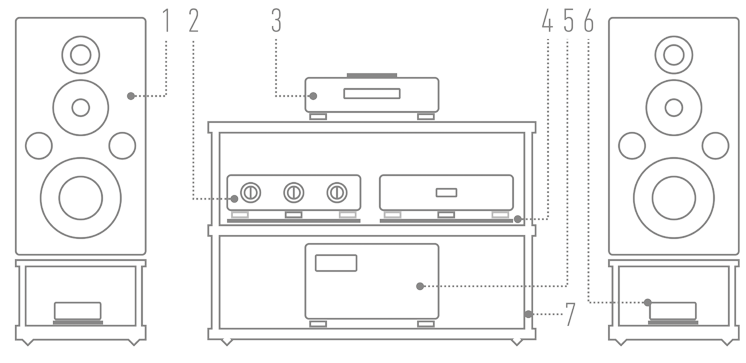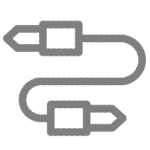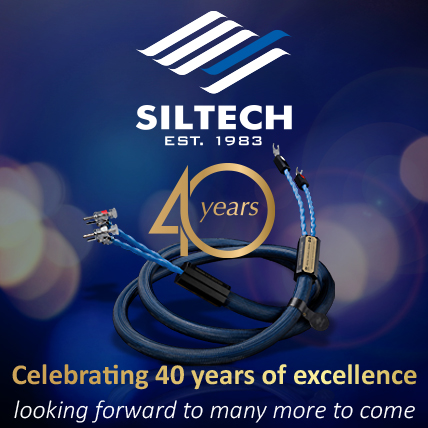|
POWER CABLE AC WARAN AUDIO
Manufacturer: WARAN FLOW |

|
Review
text by WOJCIECH PACUŁA |

|
No 258 November 1, 2025 |
|
˻ PREMIERE ˼ ⌈ The Katowice-based company WARAN AUDIO was established this year (2025), making it one of the youngest brands we’ve ever presented to you in our magazine. Its founders and designers are MAREK LYSZCZYNA and DOMINIK SZRAMA. Its range currently includes only two cables, the Java RCA interconnect and the Lava AC power cable. We are testing the latter. ⌋ WHEN I HEAR ABOUT a new Polish company, because they interest me the most, somehow they are closest to me, I feel two conflicting emotions – joy and anxiety. 
The first means a joyful welcome to someone new in our industry who can bring something positive to it, enriching it with their knowledge, passion, and personality. The second is the awareness that in 99% of cases – this is not a statistic, but my observation – such initiatives end in failure. The luxury goods market, which includes the audiophile world, is a very difficult place to succeed. What is more, like any perfectionist industry, it is also linked to technology, which further complicates its status. However, joy is stronger in me. It may seem that another manufacturer of speakers, amplifiers, or – as in the case of Waran Audio – cables, is only duplicating what has already been invented and developed before them. In reality, however, every small change, modification, or innovation leads to a better understanding of sound reproduction and, consequently, to better sound. And new manufacturers usually have a different perspective on what we do; they see things that we miss. Besides, it's an incredible adventure that has the potential to become a good way of life. Difficult, demanding, expensive, but good. ▲ A few simple words MAREK LYSZCZYNA, DOMINIK SZRAMA 
WARAN AUDIO was founded out of passion and many years of experience. It all started with a chance conversation about cables a few years ago. Neither of us was in a hurry – we were both working in our respective industries. Marek was in film production, Dominik in IT and advertising. However, we were united by a common need to seek quality in music. Over time, our conversations turned into action. Marek Lyszczyna is responsible for the business side of the project. A graduate of the Film School in Łódź and the Warsaw School of Economics, he works for TVP3 Katowice and the University of Silesia. In 2020, he founded Waran Flow, the parent company of Waran Audio, initially developing film production. The documentaries produced by the company – Moja misja (My Mission) and Zapaśnik z piekła rodem (Wrestler from Hell) – won awards at international festivals. Dominik Szrama – an electrical engineer and cable designer by profession – has been passionate about the audio market since 2004. A fan of headphone sound and the old-school Canton Quinto sound, he twisted his first cables back in 2008. In his work, he seeks above all transparency of tone, the highest sound quality, and a sound character close to analog. At the same time, he is open to modern solutions and miniaturization in audio. He comes from Grudziądz, but has lived in Silesia since childhood – it is here that he develops his projects. 
Although active in other industries on a daily basis, Waran Audio is much more than just a side project for them. It is a space where they can develop their passion for sound and experiment with sound quality. Because they do not depend on it for their professional lives, they can create without pressure, focusing fully on the music and the details that are really important to them. The entire process of arriving at the final selection of components took hundreds of hours of research, attempts to combine different solutions, and enormous financial outlays—and proved to be not only a challenge for them, but also an extraordinary adventure that continues to this day. Waran Audio plans to develop only nine products – three types of cables: RCA, AC power, and speaker cables, each in three quality and price variants. The first cables are already available on the market – RCA interconnect and AC power cables. In the long term, we want to develop our own line of components: RCA plugs, IEC/Schuko plugs, and cables. We already know how to do it – it's only a matter of time before a Polish brand of top-of-the-line audio components is created. “The dialogue between matter and sound” is not just an empty slogan for us. It is the philosophy and purpose of our work that guides us every day. » WA ▌ Lava WE NOW KNOW – WARAN AUDIO is the result of the passion of two people, Mr. Marek Lyszczyna and Damian Szrama. It is their hobby. On a daily basis, they work in completely different fields – art on the one hand, and marketing on the other. The Waran Audio brand, established this year, belongs to Mr. Marek's company, Waran Flow. The website states that although it is a young company, it has much longer experience with sound:
The website welcome all that enter with the slogan: "Copper/silver. A dialogue between matter and sound,“ which gives us a clue about the materials used by the manufacturer – copper and silver. The Lava AC power cable we are testing is made of 7N OCC silver-plated copper, which, as we read, is ”used in carefully controlled geometry." It is characterized by extensive shielding, multi-layer insulation, and an external anti-EMI braid, which is designed to create a barrier against interference, allowing the electronics to “breathe at full power.” 
The wires are insulated with polyethylene (PE) and PVC. The shielding is made of silver-plated copper braid, and additional protection is provided by two layers of PVC and a “specialized braid,” as the designer says, made of polyester and tinned copper (EMI protection). The plugs are purchased externally and are made of pure OFC copper, additionally silver-plated. Thanks to this:
The cable comes in a wooden box, which is a common choice among small manufacturers. The one from Waran Audio does not feature a lock and is tied with natural string, which gives it a rustic, cool feel. The cable itself is quite stiff and thick, but it can be arranged reasonably well in the system as long as the powered device is heavy. It looks cool, it's good craftsmanship. Only the heat-shrink sleeves with logos, placed on the plugs, look a little less stylish. The set also includes a user manual with a technical description of the cable. ▌ SOUND HOW WE LISTENED • During the listening session, the Waran Audio Lava power cable was connected to the Ayon Audio CD-35 HF Edition player (No. 1/50) and compared to my reference power cable, the AC Siltech Triple Crown. The test consisted of the AAA/BBB/AA comparison sequence, with known A and B, using short, two-minute samples from a given album. The breaks were approximately 40 seconds long. 
Both cables were plugged into the Acoustic Revive RPT-4EU Absolute AC power strip, which in turn was powered by a 2.5-meter Acrolink Mexcel 7N-PC9500 AC cable. The Acrolink was connected to a Furutech NCF wall outlet, which is fed by a separate power line with its own HPA fuse. This line is made of a 6-meter section of Oyaide Tunami Nigo cable. » RECORDINGS USED IN THE TEST ⸜ a selection
⸜ ARNE DOMNÉRUS, Jazz at the Pawnshop. Vol. I, II & III, Proprius/Lasting Impression Music LIM UHD 071 LE, 3 x CD ⸜ 1976/2012. A LARGE CABLE DIAMETER (read: thick cable) suggests a big, perhaps even exaggerated sound, right? Although it is difficult for us to admit it, our associations usually follow this line of thinking. This is how we have been “trained” by natural selection, and this is how we remain, even though for many generations we no longer have to flee from predators, scorpions, or—while we're at it—snakes. This association is therefore our “zero” point. 
In audio, linking product scale and sound scale has a long tradition and is based both on what I mentioned above and on organoleptic experience. After all, in audio, “bigger” usually means “better,” especially when it comes to damping vibrations and protecting against RF and EM interference in power amplifiers and bass response in speakers. In power cables, this usually means lower resistance and, consequently, better energy transfer, and in other cases, better protection against vibrations and interference. The Waran Audio cable is different; it behaves as if it does not belong to this stereotype. Strong, solid, thick (I am talking about its physicality), it produces a sound that is delicate, pleasant, sophisticated, simply – nice. And this is not an illusion or a momentary lapse of reason, because I repeated the comparisons many times, with different music, and I always got the same result – Lava smooths out the sound, sweetens it and tames it. In the sense that it builds a kind of intimate connection between us and the performers – it's no longer so much “there” and “here,” but more “here.” And I didn't have to look far, just play the first track on the album Jazz at the Pawnshop, ˻ 2 ˺ Limehouse Blues, to hear it. In fact, even the intro, on the reissue by Lasting Impression Music, Mr. Winston Ma's label, separated as a separate track, i.e., the musicians' preparation for the performance, was slightly quieter than with the reference cable. We turn up the volume by one or even two decibels and the fullness returns, and with it what I was talking about, namely the sweetness of everything, bringing it to a place where it comes together into a beautiful, fluid whole. |
ARNE DOMNÉRUS' album was recorded live on a Nagra IV-S stereo tape recorder and mixed live to stereo. The transfer “to us” could therefore be easy. The next album I listened to, DIANA KRALL's All For You, is a classic multi-track studio recording. Except that it was made by an outstanding duo, Al Schmitt and Tommy Li Puma, who, I remind you, passed away in 2017 (although it seems like it was yesterday, I must be getting old...). With this type of recording, it is much more difficult to create a natural impression. 
This album features exclusively songs by Nat “King” Cole, the idol of this pianist slash singer. The song ˻ 2 ˺ Gee Baby, Ain’t Good to You was originally recorded by Cole during his first-ever session for Columbia Records and was the third song to be recorded on monophonic tape at that time. Krall's version is slightly slower, also slower than the version sung by Cameron Diaz in the movie The Mask (dir. Chuck Russell, 1994). The sound of this album is open, powerful, I would even say quite bright, except for Russell Malone's warm guitar. This is how both the original CD and the two-disc LP reissue by Original Recordings Group from 2008 sound. No warmth, just speed. But also resolution. This speed and energy are also emphasized by the XRCD24 version, prepared by Mr. Kazuo Kiuchi (Harmonix, Reymio, Hijiri) together with JVC, which I listened to this time. With the Polish cable, these characteristics, i.e., openness and speed, were clear; this is not a cable that would mask sound differentiation. But at the same time, it was clear that it gave this piece a romantic charm or even smoothness. This is not a cable that separates sounds, so selectivity here is not used to isolate them from others, but to maintain clarity. It is a very clean sound. However, it does not dazzle with details, which is common in “clean” cables. Rather, it tries to connect everything on a musical level. The sound attack is rounded with it, so there will be no problems with poorly recorded albums. It's more of a tuxedo than leather and a mohawk, more tie and jacket than jeans. When necessary, as in the opening track of the MIKE BLOOMFIELD / AL KOOPER / STEVE STILLS’ Super Session album ˻ 1 ˺ Albert's Shuffle, Bloomfield's biting guitar, which plays on the first side of the album, is truly biting, it is bright, it is harsh. The same is true for the dynamic brass section that comes in after a while, or the Hammond B3 in the second part of the song. The cymbals on the right side of the drums also had a nice punch and resonance. It wasn't “paper” playing, nor was it sluggish. The blues pushed forward, without impetuosity, but with a strong “core,” as only good blues can. Written jointly by Al Kooper, the initiator of this album, and Mike Bloomfield, it sounds as if it were written many, many years earlier. And that's a big compliment. ▲ Our albums ASTOR PIAZZOLA AND HIS TANGO QUINTET Ermitage/AudioNautes Recordings AN-2309-UHQ 
BOTH THE MAIN PERFORMER, the music performed by him and his band, and the place where the recording was made – all these elements contributed to the creation of an album that has been delighting listeners for over forty years. Born in 1921, Astor Pantaleón Piazzolla was an Argentine tango composer, bandoneonist, and arranger. His compositions are widely considered to have revolutionized traditional tango and transformed it into a new style called nuevo tango, incorporating elements of jazz and classical music. The album in question was recorded at the Palazzo Dei Congressi. This is a multi-functional conference center located in Lugano, in the Swiss canton of Ticino. It is a facility designed for conferences, banquets, exhibitions, and other events, located close to the lake and the city center, near Parco Cian park. It was opened in 1975 and features high-class modernist architecture. The facility has a large auditorium for over 1,100 people and is renowned for its excellent acoustics, attractive location, and good infrastructure. 
Live in Lugano 1983 is an album that has been released quite often, also by audiophile labels, because on that evening, October 13th. 1983, the magnetic particles on the tape on which the material was recorded formed beautiful shapes. The quintet, consisting of bandoneonist Piazzolla, Hector Console (double bass), Oscar Lopez Ruiz (guitar), Pablo Ziegler (piano), and Fernando Suarez Paz (violin), was produced by Radiotelevisione della Svizzera Italiana – Rete 2. The AudioNautes Recordings version was pressed on Ultimate HQCD. This is one of the best contemporary CD production techniques, apart from Crystal Disc, invented by the Japanese company Memory Tech; more → HERE and → HERE. The release has the form known from XRCD24 releases, i.e. a hard cover, a booklet sewn inside and an envelope into which the protected disc is inserted. It is a nice, numbered machine-printed release. Interestingly, since its first release in 1992, the album has had different covers over the years – even this one from AudioNautes Recordings is different from the original, although it resembles it the most. It is a photo from a concert, very similar to the one originally chosen, but slightly different in terms of the angle from which Piazzola is seen. 
The sound on this album is incredibly spacious – something that immediately catches your attention. The reverberations on the instruments are long and fade out nicely after a while. The sound scale is also large, which is not always the case with concert recordings. The AudioNautes Recordings version also features excellent tonal saturation and very good resolution. Again, this is rather unusual for this type of album. It is also a very good musical release. Together, these elements translate into a unique experience that we enjoy through these two elements – music and sound. ● » Sound quality: 8,5-9/10 The LAVA CABLE tends to shorten reverberations and decay. In return, it offers a sound that is not close to us, it does not pull the instruments out in front of the line connecting the speakers, but rather a sound that is embedded in a saturated, clearly defined space in front of us. The reverb on the guitar in ˻ 2 ˺ Stop from the aforementioned album Super Session, this time placed in the center (the organ is on the left), was clear and lent credibility to the track. But it wasn't sustained for very long either. It had a very nice character, because it helped to open up the sound of the guitar, which was quite sweet in itself. 
Listening to these recordings, enjoying the AudioNautes Recordings release, reaching for different types of music, all these things lost some of their significance. What was important was that the designer of the Waran Audio cable had his own idea of sound. Nice, sweet, warm, rich. And energetic. In order not to slow down the presentation, the bass is presented here in good proportion to the rest of the band, where the midrange is the most important. The lower range is naturally soft, dense, and has surprisingly good punctuality, considering the nature of the cable. However, don't expect lowest notes delivered with the energy known from cables that have a more open sound; that's not what this is about. It's moody, romantic presentation. That's why jazz, older rock, and pop music by the PET SHOP BOYS will sound so cool, so pleasant. ˻ 3 ˺ Twenty-something, a track from the Super album, had a distinctive beat provided by the sound of a snare drum and synthesizers with a long reverb. When, as in ˻ 4 ˺ Groovy, the sound is more muddy and less selective, then the cable won't help. But even with this track compressed to the max, it didn't lose its resonance and didn't start to “scream.” I have a feeling that with Lava, this will not happen with any recording. It is a cable that tames such problems. ▌ Summary IF YOU ARE LOOKING FOR a neutral cable, Waran Audio's Lava is not quite for you. It is a product with a distinct character of its own. It warms up and sweetens the sound by rounding off the attack and rolling off the upper treble. These are not major changes, and the cable shows differences in recordings, pressings, etc. very well. And yet, when we listen to ABBA’S ˻ 10 ˺ SOS/i>, we know that this rather dry-sounding track has been slightly enhanced. 
It's romantic sound, I've already said that. Not overly sweet, but still leaning towards fullness, smoothness, and nice colors. It doesn't pull the back of the stage forward, because the layers are set quite far back in the mix, and in addition, with a long reverb. For example the vocals of Anna-Frid Lyngstad and Agnetha Fältskog remained in the place where I heard them with the reference cable. But everything was also denser and more focused on the midrange. That's why it's such a great option for anyone who struggles with brightness, dryness, and lack of “body” in their systems. This is a truly high-end cable just for them. » HF ▌ Technical specifications according to the manufacturer):
IEC plug: C15 form the device side 
THIS TEST HAS BEEN DESIGNED ACCORDING TO THE GUIDELINES adopted by the Association of International Audiophile Publications, an international audio press association concerned with ethical and professional standards in our industry, of which HIGH FIDELITY is a founding member. More about the association and its constituent titles → HERE. |
|
Reference system 2025 |
|
 1) Loudspeakers: HARBETH M40.1 |REVIEW| 2) Line preamplifier: AYON AUDIO Spheris III Linestage |REVIEW| 3) Super Audio CD Player: AYON AUDIO CD-35 HF Edition No. 01/50 |REVIEW| 4) Stands (loudspeakers): ACOUSTIC REVIVE (custom) |ABOUT| 5) Power amplifier: SOULUTION 710 6) Loudspeaker filter: SPEC REAL-SOUND PROCESSOR RSP-AZ9EX (prototype) |REVIEW| 7) Hi-Fi rack: Hi-Fi rack: finite elemente MASTER REFERENCE PAGODE EDITION Mk II, more → HERE |
|

|
Cables Analog interconnect SACD Player - Line preamplifier: SILTECH Triple Crown (1 m) |ABOUT|» ANALOG INTERCONNECT Line preamplifier → Power amplifier: Siltech ROYAL SINLGE CROWN RCA; review → HERE Speaker cable: SILTECH Triple Crown (2.5 m) |ABOUT| |

|
AC Power Power cable | Mains Power Distribution Block - SACD Player: SILTECH Triple CrownPower (2 m) |ARTICLE| » POWER CABLE Mains Power Distribution Block → Line preamplifier: Acoustic Revive ABSOLUTE-POWER CORD, review → HERE » POWER CABLE Mains Power Distribution Block → Power amplifier: Acoustic Revive ABSOLUTE-POWER CORD, review → HERE Power cable | Power Receptacle - Mains Power Distribution Block: ACROLINK Mexcel 7N-PC9500 (2 m) |ARTICLE| Power Receptacle: Acoustic Revive RTP-4eu ULTIMATE |REVIEW| » ANTI-VIBRATION PLATFORM under Acoustic Revive RTP-4eu ULTIMATE: Graphite Audio CLASSIC 100 ULTRA, review → HERE Power Supply Conditioner: Acoustic Revive RPC-1 |REVIEW| Power Supply Conditioner: Acoustic Revive RAS-14 Triple-C |REVIEW| Passive filter EMI/RFI: VERICTUM Block |REVIEW| |

|
Anti-vibration Speaker stands: ACOUSTIC REVIVE (custom)Hi-Fi rack: finite elemente MASTER REFERENCE PAGODE EDITION Mk II, more → HERE Anti-vibration platforms: ACOUSTIC REVIVE RAF-48H |ARTICLE| » ANTI-VIBRATIONAL FEET: |

|
Analogue Phono preamplifier: Phono cartridges:
Clamp: PATHE WINGS Titanium PW-Ti 770 | Limited Edition Record mats:
|

|
Headphones » HEADPHONE AMPLIFIER: Leben CS-600X, review → HEREHeadphones: Headphone Cables: Forza AudioWorks NOIR HYBRID HPC |
main page | archive | contact | kts
© 2009 HighFidelity, design by PikselStudio,
projektowanie stron www: Indecity








